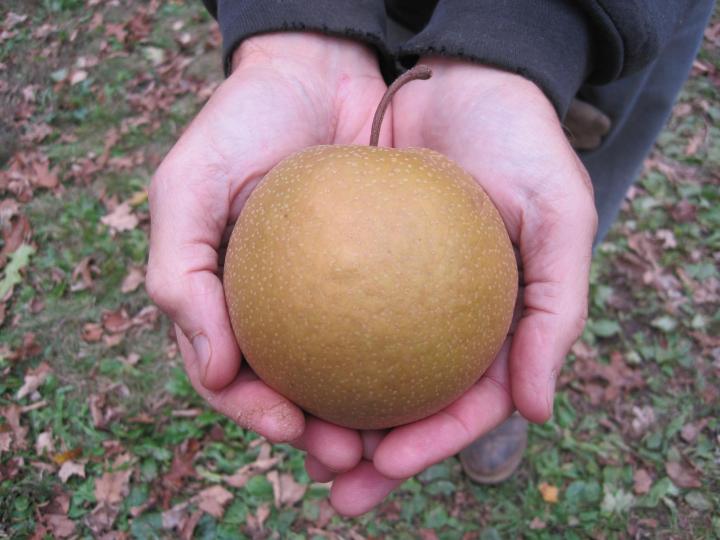Meet Asian pears—among the finest fruits I’ve ever grown. They have the juicy white flesh and lovely bouquet of a pear but they are round and can be eaten crisp off the tree like an apple. Plus, this fruit is low in acidity, stores for many months, and is easy to grow.
Asian Pears Versus European Pears
Unlike the European pears that get a gritty texture inside if left to ripen on the tree, Asian pears are tree-ripened and won’t continue to ripen once picked. They are good keepers, lasting almost 2 weeks at room temperature and up to 5 months in the refrigerator.

Asian Pear Origins
Asian pears were brought to this country over 160 years ago by immigrants wanting to bring a familiar food to their new home but the fruit did not become widely popular here until the 1980’s.
Because they are round they are often called “apple pears” and sometimes are referred to as “water pears” because they are so juicy.

Even though they feel firm when ripe they bruise easily which is why the ones in the store often appear wrapped in a cozy mesh koozie. They are excellent eaten raw or can be baked into a pie or pear crisp or steamed and drizzled with honey for a traditional Chinese treat. In Japan, slices of peeled pears are often served after dinner.
Asian Pear Varieties
If you are considering adding Asian pears to your edible landscape these dwarf trees can be a nice ornamental bearing pure white blossoms in the spring. There are many varieties to choose from so do some taste testing of the fruit before you decide. The flavors are subtle and vary from butterscotch to honey to banana to floral to cinnamon but all are crisp and juicy.
Most Asian pears grow similar to European pears in zones 5 to 9 with some varieties that grow in cooler or warm zones. Here are a few popular varieties for home gardens:
- ‘Hosui’ is perhaps the finest tasting Asian pear with beautiful golden skin, juicy sweet-tart flesh, and a firm, apple-like crunch. This tree grows 10 to 16 feet tall and fruit ripens from mid-August to late September.
- ‘Chojuro Asian Pear’ is the most popular Asian pear variety with the flavor of butterscotch and a storage life of up to five months. In home gardens, plant the dwarf variety.
- ‘Shinseiki’ is known for the wide range of climates in which this fruit can thrive from warm to cold. The fruit is bright yellow and very juicy. It’s half the size of the other pears but produces double the volume and makes a perfect snack-size pear.
 We grew ‘Hardy Giant’ which lives up to its name, producing many huge fruits.
We grew ‘Hardy Giant’ which lives up to its name, producing many huge fruits.
Growing Asian Pears
They are not reliable self-pollinators so they will produce better if planted with another Asian variety that blooms at the same time. A European pear such as ‘Bartlett’ can also serve as a pollinator. If you are cramped for space look for a 3-in-1 or 4-in-1 multi-budded plant. These trees will have 3 or 4 different varieties grafted onto a single rootstock.

Like European pears, they are cold-hardy and need to chill out in winter, requiring at least 50 to 70 days of temperatures below 45 degrees Fahrenheit, so they do best in zones 5 to 8.
They can take some shade and tolerate a wide range of soil types but prefer full sun with well-drained, slightly acidic soil.
Pest- and disease-resistant, there is little that troubles these trees. I am used to animals raiding my fruit before I can pick it but nothing bothers the Asian pears. Codling moth is the most common pest and fire blight the most common disease but neither one has given us any trouble.
How to Plant Asian Pears
- Plant the bare-root trees in spring or autumn in full sun and well-drained soil with its graft union (a knob at bottom of trunk) 2 to 4 inches above the soil.
- When planting, position the graft 3 inches above the soil line.
- Since the tree’s shape is naturally upright you can plant them 10 to 15 feet apart but they could also be grown as espaliers on a fence or trellis.

- Water young trees deeply once a week. Mulch every spring with compost.
- It will take 2 to 3 years to fruit. The trees develop many fruiting spurs all along the branches so to encourage bigger pears, thin to one fruit every six inches once the fruits are the size of a cherry. It’s important to thin to avoid disease as good fruit size and yield.
- If you do have pests, consider a dormant oil spray or buy beneficial parasitic trichogramma wasps to release in spring.
-
To judge when to harvest, taste test almost daily and keep an eye on the skin color which will change; the fruit should still be firm, never soft and overripe. Do not pick too soon or the sugars won’t fully develop.
-
Remember to be gentle when picking Asian pears to avoid bruising. The pear, like an apple, should fall off fairly easy; do not pull hard.
Go out on a limb! Asian pears may sound like an exotic fruit but they are actually easy to grow and quite delicious.
→ Read more about growing pears.




 We grew ‘Hardy Giant’ which lives up to its name, producing many huge fruits.
We grew ‘Hardy Giant’ which lives up to its name, producing many huge fruits.








